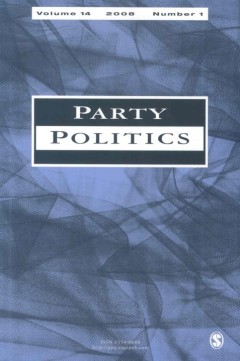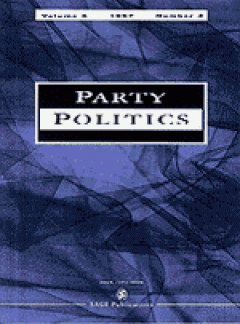Filter by

Why Is There No Christian Democracy in Poland - and Why Should We Care?
Despite the fact that almost all Poles are Roman Catholics and that religion has played an important part in contemporary Polish politics, no self-declared Christian Democratic party has been successful in post-1989 Poland. None of the currently successful Polish centre—right parties profile themselves as Christian Democratic, nor can they be labelled as such objectively. While, superficially,…
- Edition
- Vol. 14, No. 4, July 2008. Page 479-500
- ISBN/ISSN
- 13540688
- Collation
- -
- Series Title
- Party Politics
- Call Number
- -

Searching for the Right Organization: Ideology and Party Structure in East-Ce…
The article examines four centre—right parties in East-Central Europe in order to assess the impact of ideology on party organization and revisit the thesis of organizational weakness in the region. The data collected indicate that, together with electoral success, inherited resources and national context, ideology does indeed shape the style of organization. Centre—right parties, as opposed …
- Edition
- Vol. 14, No. 4, July 2008. Page 455-477
- ISBN/ISSN
- 1354-0688
- Collation
- -
- Series Title
- Party Politics
- Call Number
- -

Europeanization as Heresthetics: Party Competition over Self-Government for S…
This article is a theoretical and empirical contribution to the study of the Europeanization of political parties. On the theoretical side, it draws on the concepts of heresthetics and two-level games to conceptualize a Europeanization mechanism that has so far been overlooked in the literature. It shows that Europeanization can be a heresthetic tool in party competition, notably in terms of op…
- Edition
- Vol. 15, No. 1, January 2009 pp. 49-68
- ISBN/ISSN
- 13540688
- Collation
- -
- Series Title
- Party Politics
- Call Number
- -

Populists, Outsiders and Anti-Establishment Politics
In this article, I attempt to clarify the relationships among three contemporary concepts that are often used interchangeably or conflated in the literature: anti-establishment politics, political outsiders and populism. In order to make sense of these manifestations of public discontent, I argue that one must examine the nature of political appeals, political actors' locations vis-ŕ-vis the pa…
- Edition
- Volume 15, Number 1, January 2009. pp. 29-48
- ISBN/ISSN
- 1354-0688
- Collation
- -
- Series Title
- Party Politics
- Call Number
- -

Government Formation in Multi-Level Settings: Spanish Regional Coalitions and…
It is generally assumed that in multi-level political systems political actors desire to form regional coalitions that match the party composition of the coalition governing at the central level, and that where this matching attempt does not occur it is because a possible new coalition formula for the central level is being tested at the regional one. This article shows that the congruence of p…
- Edition
- Volume 15, Number 1, January 2009. pp. 93-115
- ISBN/ISSN
- 1354-0688
- Collation
- -
- Series Title
- Party Politics
- Call Number
- -

Taking Europe To Its Extremes
This article revisits the age-old debate about elite—mass linkages in the European Union (EU) by examining the way in which political contexts shape individual differentiation in Euroscepticism. We argue that the growing uncertainties about the future of European integration among national publics are increasingly politicized by Eurosceptical elites on both the extreme right and left of the pol…
- Edition
- Volume 15, Number 1, January 2009. pp. 5-28
- ISBN/ISSN
- 13540688
- Collation
- -
- Series Title
- Party Politics
- Call Number
- -

The Dynamic Character of Political Party Evaluations
Over the past 50 years, the American public has consistently been asked to compare the two major parties' ability to handle a variety of issues. The meaning of their answers is an under-studied phenomenon. In this article, I explore changes in comparative party evaluations over time and the source of those changes in attitudes towards the parties. Previous research is based on the assumption th…
- Edition
- Volume 15, Number 1, January 2009. pp. 69-92
- ISBN/ISSN
- 13540688
- Collation
- -
- Series Title
- Party Politics
- Call Number
- -

Understanding Post-Devolution Elections in Scotland and Wales in Comparative …
In this article, we explore the electoral dynamics of multi-level political systems for the case of the United Kingdom (Scotland and Wales) through a comparison with multi-level voting behaviour in Germany, Spain and Canada. The analysis suggests that sub-state elections can be `second order' in relation to state-wide elections, but that this `second orderness' is reduced when more powers are d…
- Edition
- Vol. 15, No. 2, September 2009. pp. 219-240
- ISBN/ISSN
- 13540688
- Collation
- -
- Series Title
- Party Politics
- Call Number
- -

Multi-Level Relations in Political Parties: A Delegation Approach
Most political parties operate on several territorial levels, but we have only limited theoretical understanding of multi-level party dynamics. This article presents a delegation framework for studying the interaction between the national leadership and regional branches in state-wide parties. Assuming a principal—agent relationship, the national leadership can obtain benefits from delegating t…
- Edition
- Vol. 15, No. 2, September 2009.pp. 137-156
- ISBN/ISSN
- 13540688
- Collation
- -
- Series Title
- Party Politics
- Call Number
- -

Patterns of Party Integration, Influence and Autonomy in Seven Federations
In this article, I develop three measures of party organization in multi-level systems: vertical integration, influence and autonomy. I assess these in 27 parties in Canada, Australia, Germany, Austria, Switzerland, the United States and Spain and investigate how parties respond to the incentives and opportunities created by their institutional environment. Clear patterns emerge between the for…
- Edition
- Vol. 15, No. 2, September 2009.pp. 157-177
- ISBN/ISSN
- 13540688
- Collation
- -
- Series Title
- Party Politics
- Call Number
- -

Party Matters: Devolution and Party Politics in Britain and Spain
This article addresses the relationship between political decentralization and the organization of political parties in Great Britain and Spain, focusing on the Labour Party and the Socialist Party, respectively. It assesses two rival accounts of this relationship: Caramani's `nationalization of politics' thesis and Chhibber and Kollman's rational choice institutionalist account in their book T…
- Edition
- Vol. 15, No. 2, September 2009.pp. 179-198
- ISBN/ISSN
- 1354-0688
- Collation
- -
- Series Title
- Party Politics
- Call Number
- -

The Saliency of Regionalization in Party Systems: A Comparative Analysis of R…
The article centres on the saliency that regional decentralization has had for British, Italian and French political parties in the past 60 years. A longitudinal analysis of the emphasis that parties have assigned to this issue in their manifestos confirms the hypothesis that certain environmental factors influence the changes of attention of parties on regionalization in their electoral discou…
- Edition
- Vol. 15, No. 2, September 2009.pp. 199-218
- ISBN/ISSN
- 13540688
- Collation
- -
- Series Title
- Party Politics
- Call Number
- -

Clientelism Versus Ideology: Problems of Party Development in Brazil
Although aggregate data on party competition in Brazil seem hopeful, unsettling trends appear in state-level party systems in the years of the consolidation of Brazilian democracy (the period this article examines extends through the 2002 elections), such as instability and fragmentation, which exceed the extent of problems apparent at the national level. These hamper the informational role par…
- Edition
- Volume 15, Number 3, May 2009. pp. 335-355
- ISBN/ISSN
- 13540688
- Collation
- -
- Series Title
- Party Politics
- Call Number
- -

Patrons Against Partisans: The Politics of Patronage in Mass Ideological Parties
Patronage is an enduring feature of contemporary politics and may well develop in modern, mass organized and ideological political parties. This article approaches patronage in an analytical way, and seeks to explore its micro-foundations and logic of development. As the case of Greece's socialist party suggests, patronage is the deliberate outcome of choices made by political actors at the sub…
- Edition
- Volume 15, Number 3, May 2009. pp. 315-334
- ISBN/ISSN
- 13540688
- Collation
- -
- Series Title
- Party Politics
- Call Number
- -

Measuring the Professionalization of Political Campaigning
This article develops and tests a new multidimensional index — CAMPROF — that is designed to measure and compare parties' use of professionalized campaign techniques during elections. Based on the extant literature, we identify and operationalize the essential components of this new form of campaigning to create a 30-point index that is applied to the case of the 2005 German federal election. T…
- Edition
- Volume 15, Number 3, May 2009. pp. 265-293
- ISBN/ISSN
- 13540688
- Collation
- -
- Series Title
- Party Politics
- Call Number
- -

Party Preferences and Economic Voting in Turkey (Now That the Crisis Is Over)
The purpose of this study is to re-examine the factors that shape party preferences in Turkey by estimating an individual vote intention function. The economic variables in the empirical model are items that can be used to test the conventional `economic voting' hypotheses, i.e. whether individuals' economic evaluations about the past or the near future affect their party choice. In an earlier …
- Edition
- Volume 15, Number 3, May 2009. pp. 377-391
- ISBN/ISSN
- 1354-0688
- Collation
- -
- Series Title
- Party Politics
- Call Number
- -

The Rise and Fall of the Argentine Centre—Left: The Crisis of Frente Grande
This article analyses the inner workings of the Argentinian Frente Grande party at the height of its political and electoral development. It is based on the assumption that parties are not singular actors, but diverse organizations with complex internal operations. From that perspective, in order to identify the causes of both its rapid growth and current crisis, the article examines the distri…
- Edition
- Volume 15, Number 3, May 2009. pp. 357-375
- ISBN/ISSN
- 13540688
- Collation
- -
- Series Title
- Party Politics
- Call Number
- -

Party Strategy or Candidate Strategy: How Does the LDP Run the Right Number o…
Under the single non-transferable vote (SNTV), political parties are faced with the strategic problem of matching the number of candidates to their vote total. Running either too many or too few candidates may lose a seat that could otherwise have been won. Many studies have confirmed that Japan's Liberal Democratic Party (LDP) solved this strategic problem relatively well and ran close to the …
- Edition
- Volume 15, Number 3, May 2009. pp. 295-314
- ISBN/ISSN
- 13540688
- Collation
- -
- Series Title
- Party Politics
- Call Number
- -

It's About The Benefits:Choice Environments, Ideological Proximity and Indivi…
This article approaches the question of turnout by focusing on the benefits term in the classic equation through an examination of the relationship between the quality of the choice environment, ideological proximity and participation in 28 democracies. Using data from the CSES (Comparative Study of Electoral Systems), I find that electoral contexts that feature choice-rich environments, measur…
- Edition
- Volume 15, Number 4, July 2009. pp. 435-454
- ISBN/ISSN
- 1354-0688
- Collation
- -
- Series Title
- Party Politics
- Call Number
- -

Rethinking Factionalism: Typologies, Intra-Party Dynamics and Three Faces of …
It is time to think again about the conceptualization of factionalism in political science. Following a brief review of scholarly contributions in the field, I argue that the analytical approach based on typologies and categories of subparty groups is not very useful in explaining intra-party behaviour and the process of change because, by their nature, these are static tools. Building on previ…
- Edition
- Volume 15, Number 4, July 2009. pp. 455-485
- ISBN/ISSN
- 1354-0688
- Collation
- -
- Series Title
- Party Politics
- Call Number
- -
 Computer Science, Information & General Works
Computer Science, Information & General Works  Philosophy & Psychology
Philosophy & Psychology  Religion
Religion  Social Sciences
Social Sciences  Language
Language  Pure Science
Pure Science  Applied Sciences
Applied Sciences  Art & Recreation
Art & Recreation  Literature
Literature  History & Geography
History & Geography